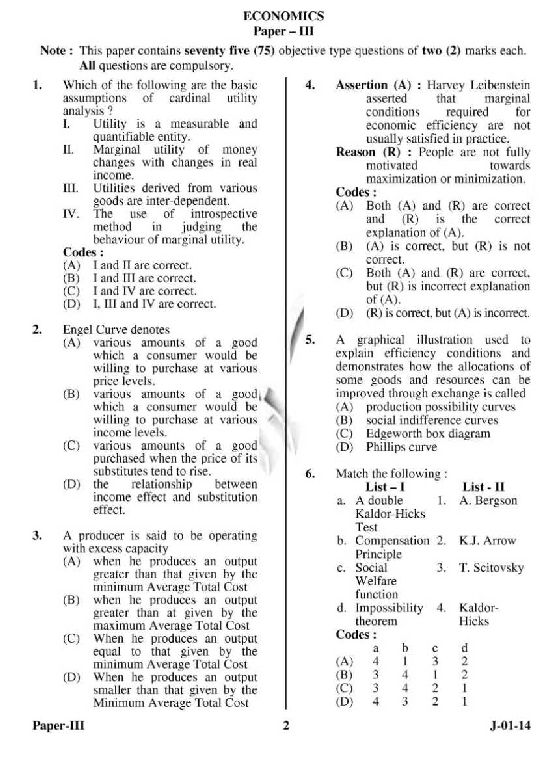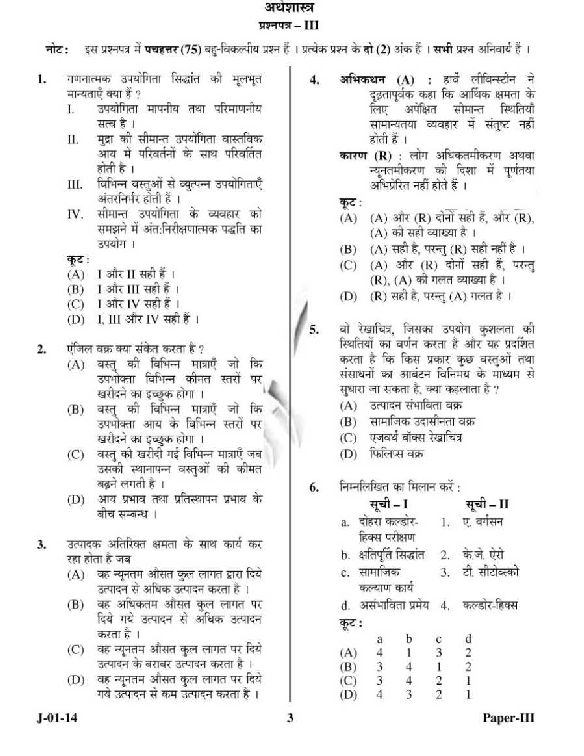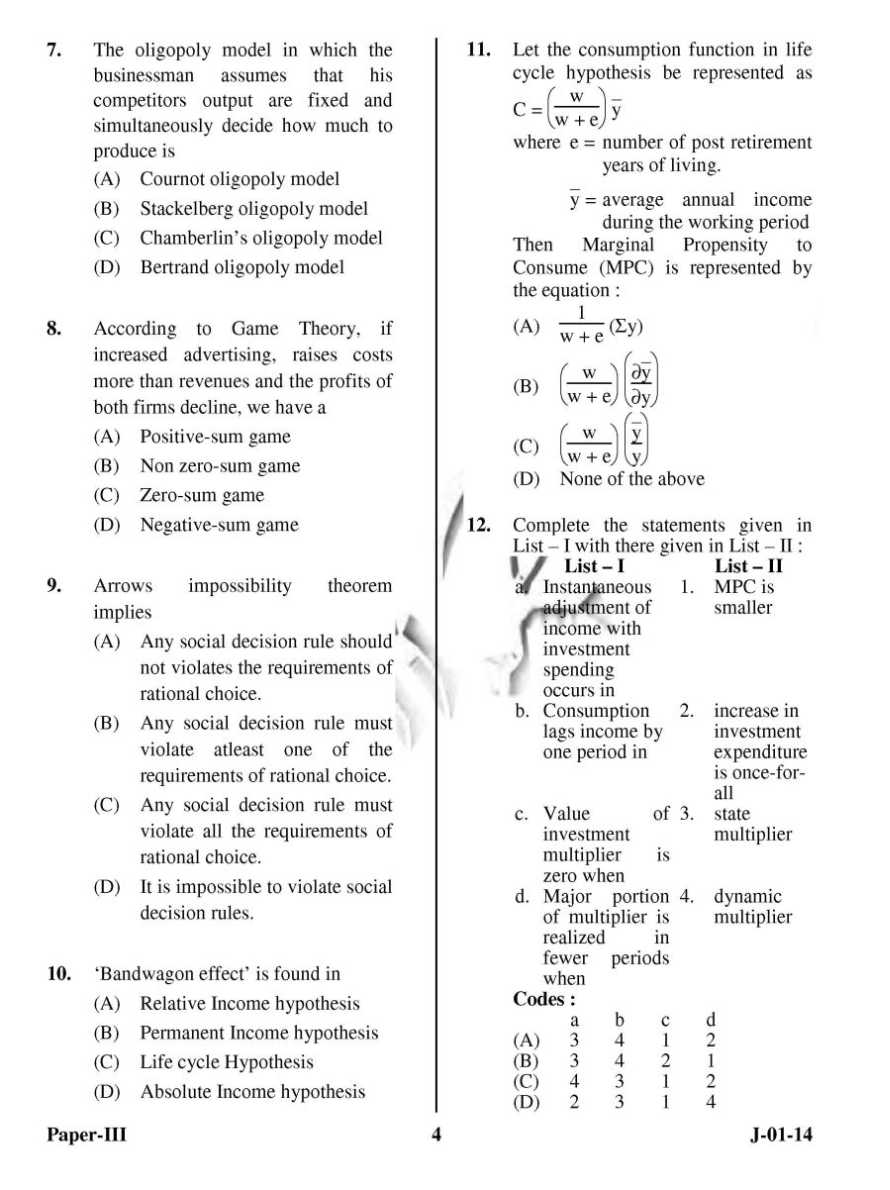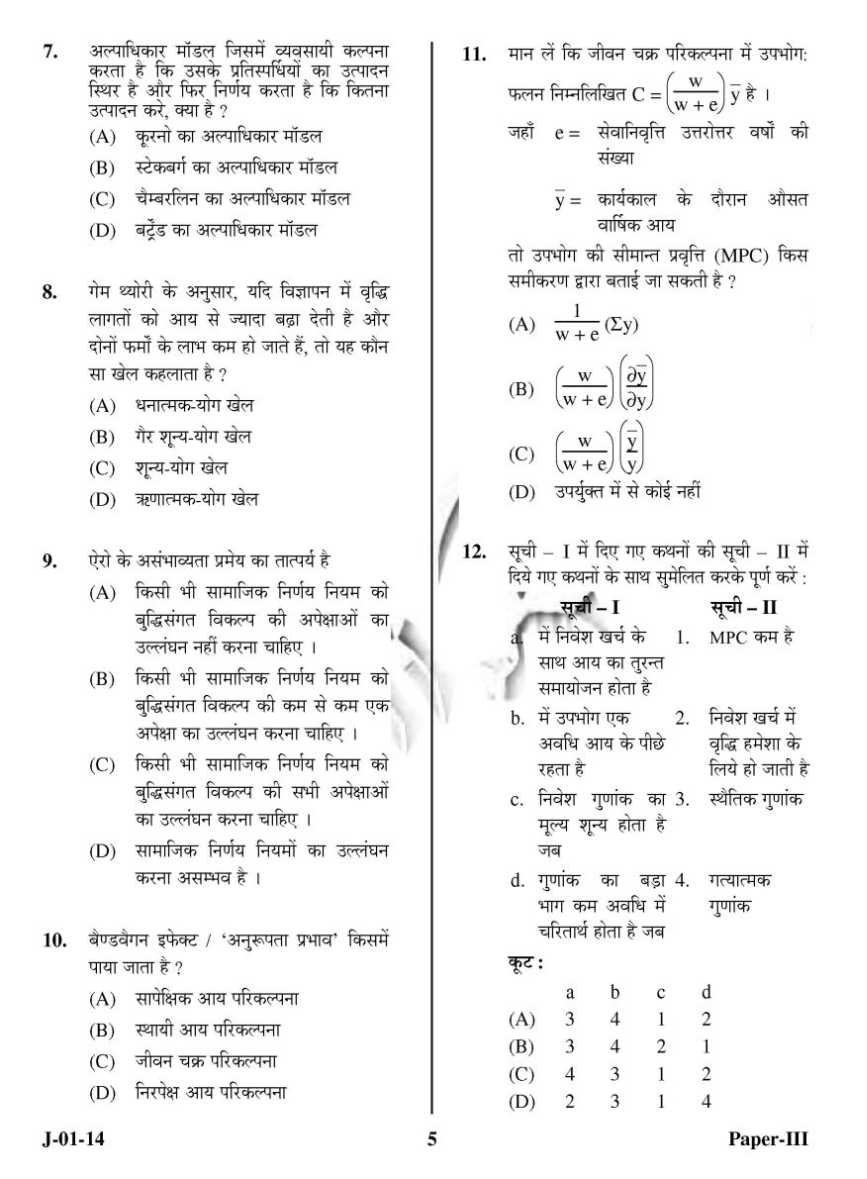|
#1
| |||
| |||
|
Provide me question paper NET economics examination organized by university grant commission ?
|
|
#2
| ||||
| ||||
|
Here I am giving you question paper NET economics examination organized by university grant commission in PDF file attached with it . 1. The cost incurred by the firm in hiring labour is called as (A) Explicit Cost (B) Implicit Cost (C) Marginal Cost (D) Total Cost 2. The locus of Pareto Optimality in Production and Consumption is given by (A) The Social Welfare Function (B) The Utility Possibility Curve (C) The Transformation Curve (D) The Grand Utility Possibility Curve 3. List – I List – II a. Tea and Coffee 1. Veblen goods b. Car and Petrol 2. Substitutes c. Gold and Diamonds 3. Giffen goods d. Ragi and Bajra 4. Complementary Codes : a b c d (A) 2 1 3 4 (B) 2 4 1 3 (C) 4 1 2 3 (D) 4 3 1 2 4. Assertion (A) : In the short run under perfect competition, given the market demand and market supply the industry is in equilibrium at that price which clears the market. Reason (R) : In the long run all the firms in the industry earn profit. Codes : (A) Both (A) and (R) are true and (R) is the correct explanation of (A). (B) Both (A) and (R) are true, but (R) is not the correct explanation of (A). (C) (A) is true, but (R) is false. (D) (A) is false, but (R) is true. 5. Put the following in chronological order on the basis of development : i. Law of Demand ii. Revealed Preference Analysis iii. Indifference Curve Analysis iv. Law of Diminishing Marginal Utility (A) i iii ii iv (B) i iv iii ii (C) i ii iv iii (D) i iii iv ii 6. If the monopolist incurs loss in the short run, then in the long run a. he will go out of business b. he will stay in business c. he will break even d. any of the above is possible (A) a and b (B) a and c (C) a only (D) d only 7. The condition of Pareto Optimality holds correct under (A) Perfect Competition (B) Monopolistic Competition (C) Oligopoly (D) Monopoly 8. Assertion (A) : Compared to the individual supply curve, the aggregate supply curve is more elastic. Reason (R) : There is the possibility of moving between being out of the labour force and being in the labour force. Choose amongst the following the correct answer. Codes : (A) (A) is correct, but (R) is not the correct explanation of (A). (B) (A) is correct and (R) is the correct explanation of (A). (C) (A) is correct, but (R) is incorrect. (D) (A) is incorrect, but (R) is correct. 9. Assuming life cycle hypothesis, let a person starts working when he is 20 years old, works until the age of 60 and expects to die at the age of 70. If this person earns, say ` 1.50 lac annually when he is 20-30 years, ` 2 lac annually when he is 30-45 years, and ` 3 lac annually when he is 40- 60 years, then his life time average propensity to consume is (A) 0.60 (B) 0.70 (C) 0.80 (D) 0.90 10. With reference to demand for money, match List – I with List – II : List – I List – II a. Demand for money is stable 1. J.M. Keynes b. Liquidity Preference as behaviour towards risk 2. W. Baumol c. Inventory Theoretic Approach 3. James Tobin d. No portfolio diversification 4. Milton Friedman Codes : a b c d (A) 4 3 1 2 (B) 3 4 1 2 (C) 2 1 3 4 (D) 4 3 2 1 11. The negative relationship between the gap between actual GDP and its trend value and the difference between actual unemployment rate and its equilibrium value is called (A) The Aggregate Supply Curve (B) The Phillips Curve (C) The Natural Rate of Unemployment Hypothesis (D) Okun’s Law 12. It is often true that as the economy begins to recover from a recession, the unemployment rate rises because (A) as the economy initially recovers from a recession the demand for goods and services falls, so the demand for workers falls. (B) as the economy begins to recover from a recession, workers who were previously discouraged about their chances of finding a job begin to look for work again. (C) as the economy begins to recover from a recession because of the errors in the way the data are collected. (D) as the economy initially recovers from a recession, firms do not immediately increase the number of workers they hire. Firms wait to hire more individuals until they are convinced that the recovery is strong. 13. When additional government expenditure is financed by selling government securities, then what will be the nature of crowding out effect, given in List – I in the context of the situation given in List – II ? List – I Crowding out effect List – II Situation a. Full 1. Keynesian Range b. Partial 2. Classical Range c. Nil 3. Intermediate Range Codes : a b c (A) 2 3 1 (B) 3 1 2 (C) 1 3 2 (D) 1 2 3 14. Match items given in List – I with those in List – II : List – I List – II a. Equation of Exchange 1. J.M. Keynes b. Cash Balances Approach 2. Irving Fisher c. Regressive Expectation model of Demand for Money 3. W.J. Baumol d. Square Root Formula of Demand for Money 4. A.C. Pigou and Alfred Marshall Codes : a b c d (A) 2 4 1 3 (B) 3 2 4 1 (C) 4 3 1 2 (D) 1 3 2 4 15. The premise, that benefit of economic growth will reach all sections of population is called (A) Trickle up effect (B) Trickle down effect (C) Take-off effect (D) Backlash effect 16. In whose growth model, entrepreneur’s significance is pivotal ? (A) Keynes (B) Schumpeter (C) Harrod (D) Domar 17. The classical model of economic development emphasises (A) Laissez-Faire Policy (B) Capital Accumulation (C) Both (A) and (B) (D) None of these 18. Which one of the following pairs is not correctly matched ? Author Book (A) Simon Kuznets Asian Drama (B) J. Robinson Essays in the Theory of Economic Growth (C) Karl Marx Das Kapital (D) A.W. Lewis Theory of Economic Growth 19. What does change in economic growth ? (A) Structure of economy (B) Mindsets of people (C) National Income (D) None of these 20. Which States/U.Ts. have been placed at first three places in Gender Development Index List 2006 made by the Government of India ? (A) Kerala, Chandigarh, Goa (B) Kerala, Goa, Chandigarh (C) Chandigarh, Goa, Kerala (D) Goa, Kerala, Chandigarh 21. Assertion (A) : There is no incentive for a profit maximizing producer to supply the public goods. Reason (R) : If he produces it he is unable to exclude people from consuming it and hence he cannot charge a price. Codes : (A) (A) is true, but (R) is false. (B) Both (A) and (R) are false. (C) (A) is not correct, but (R) is correct (D) Both (A) and (R) are correct and (R) is the correct explanation of (A). 22. The distribution of the burden of paying a tax is called (A) Sharing of tax burden (B) Shifting of the tax (C) Incidence of a tax (D) Tax capitalization 23. Which one of the following is short period debt meant to meet current needs, that is filling temporary gap in budgets ? (A) Funded debt (B) Unfunded debt (C) Redeemable debt (D) Irredeemable debt 24. Monetised deficit means (A) Fiscal deficit less interest payments (B) Government expenditure which is financed through the sale of adhoc treasury bills. (C) Increase in RBI credit to Central Government. (D) Fiscal deficit less loans and advances. 25. A proportionate increase in tax revenue to a proportionate increase in the tax base is called (A) Elasticity of a tax (B) Buoyancy of a tax (C) Neutrality of a tax (D) None of the above 26. ‘Vent for surplus approach’ is applicable to (A) Rich countries (B) Underdeveloped countries (C) Oil exporting countries (D) None of the above 27. According to monetary approach, a revaluation of a nation’s currency (A) increases the nation’s demand for money. (B) increases the nation’s supply of money (C) reduces the nation’s demand for money (D) reduces the nation’s supply of money 28. The Bretton Woods System was based on (A) a gold standard (B) a flexible exchange rate system (C) a gold exchange standard (D) none of the above 29. The imposition of an import tariff by a large nation (A) usually improves the nation’s terms of trade and increases the volume of trade. (B) worsens the nation’s terms of trade but increases the volume of trade (C) worsens the nation’s terms of trade and reduces the volume of trade. (D) usually improves the nation’s terms of trade but reduces the volume of trade. 30. The value of foreign trade multiplier will be high under the condition when (A) marginal propensity to save is high (B) marginal propensity to import is high (C) there is increase in exports (D) marginal propensity to consume domestic goods is high 31. Match the weight of different industry groups between List-I & List-II : List – I List – II a. Basic goods industries 1. 45.7 b. Capital goods industries 2. 8.8 c. Intermediate goods industries 3. 15.7 d. Consumer goods industries 4. 29.8 Codes : a b c d (A) 1 2 3 4 (B) 2 4 3 1 (C) 3 2 1 4 (D) 1 3 4 2 32. Plant load factor of thermal power stations in India in recent years has been around (A) 50 percent (B) 60 percent (C) 70 percent (D) 80 percent 33. Which of the following is not the part of National Telecom Policy (NTP) 2012 in India ? (A) Strive to create One-Nation- One License across services and service areas. (B) Achieve One Nation – Full Mobile number portability (C) To work towards ‘Right to Broadband’ (D) Recognize telecom as basic goods industry 34. Percentage share of the manufacturing output of India in the world total is now (A) 2.2 percent (B) 3.9 percent (C) 6.2 percent (D) 7.5 percent 35. India’s current account deficit in Balance of Trade is mainly due to (a) Increasing imports of oil and petroleum (b) Increasing imports of gold and silver (c) Increasing imports of food grains (d) Increasing imports of iron and steel Codes : (A) (a), (b) and (c) (B) (a) and (c) (C) (a) and (b) (D) (a) and (d) 36. The MRTP Act of 1969 has been (A) replaced by Competition Act 2002 (B) merged in Industrial Policy Act of 1978 (C) replaced by Trade Union (Amendment) Act 2001 (D) merged in Industrial Policy Act of 1991 37. In the context of agricultural development the trickle down theory has been interpreted to suggest that a. Growth in agriculture output without radical institutional reforms will reduce the incidence of poverty. b. Growth in agriculture output with radical institutional reforms will reduce the incidence of poverty c. Only radical institutional reforms can reduce the incidence of poverty. d. Only growth in agriculture output will reduce incidence of poverty. (A) Both a and b (B) Both a and c (C) b only (D) d only 38. As per the latest figures of the Ministry of Agriculture the per capita per day foodgrains availability is (A) 280 gm (B) 440 gm (C) 580 gm (D) 900 gm 39. In which year the Kissan Credit Card System was introduced ? (A) 1978 (B) 1998 (C) 1988 (D) 2008 40. Assertion (A) : PL-480 grants was used to import foodgrains. Reason (R) : PL-480 grants facility was granted by Japan. Codes : (A) Both (A) and (R) are true and (R) is the correct explanation of (A). (B) Both (A) and (R) are true and (R) is not the correct explanation of (A). (C) (A) is true, but (R) is false. (D) (A) is false, but (R) is true. 41. Productivity of groundnut is highest in (A) U.S.A. (B) Mexico (C) India (D) China 42. NAFED is a (A) Company (B) Non-Government Organisation (C) Government Body (D) Cooperative Organisation 43. Based on the SRS data for 2010 in India, which of the following seems to be incorrect ? (A) TFR = 2.5 (B) CDR = 7.2 (C) IMR = 48.9 (D) CBR = 24.2 44. Upto which census, synchronous de facto method was adopted in India wherein the census was conducted throughout the country in a single night ? (A) 1901 (B) 1931 (C) 1951 (D) 1971 45. Match the following : Group – I Group – II a. Type II error 1. P01 × P10 = 1 b. Mean > Mode 2. Probability of not rejecting H0 when it was not true c. Population is homogenous 3. Positively skewed distribution d. Time Reversal Test 4. Simple random sampling Codes : a b c d (A) 2 3 4 1 (B) 3 1 2 4 (C) 4 2 3 1 (D) 1 2 3 4 46. Assertion (A) : For normal distribution Mean = Median = Mode. Reason (R) : Normal distribution is mesokurtic. Codes : (A) Both (A) and (R) are correct and (R) is the correct explanation of (A). (B) Both (A) and (R) are correct but (R) is not the correct explanation of (A). (C) (A) is correct, but (R) is incorrect. (D) (A) is incorrect, but (R) is correct. 47. Given the two regression lines estimated from given data as under : Y = 4 + 0.4X X = –2 + 0.9Y Then coefficient of correlation between X and Y will be (A) 0.4 (B) 0.5 (C) 0.6 (D) 0.8 48. Which of the following satisfy time reversal test but not factor reversal test ? (A) Laspeyre’s Index No. (B) Fisher’s Index No. (C) Paasche’s Index No. (D) Marshall-Edgeworth Index No. 49. The value of χ2 in a 3 × 5 contingency table is computed as 8.0. The Null hypothesis of no association will be tested at 5% level of significance, if this value is less than or equal to the value of χ2 from the table at degrees of freedom : (A) 8 (B) 6 (C) 4 (D) 3 50. Which is a non-probability based sampling method ? (A) Systematic Sampling (B) Stratified Random Sampling (C) Quota Sampling (D) Simple Random Sampling
__________________ Answered By StudyChaCha Member |
|
#4
| |||
| |||
|
The National Eligibility Test (Net) exam is conducted by Central Board Of Secondary Education for determining the eligibility of students for Assistant Professor or Junior Research Fellowship both in Indian universities and colleges. CBSE UGC NET Syllabus for Economics UGC NET Economics Syllabus Subject : Economics / Rural Economics / Co – operation / Demography / Development Planning / Development Studies / Econometrics / Applied Economics / Development Eco. / Business Economics. Paper pattern There will be two Question Papers I, Paper II UGC NET Paper III ( Part A & B ). UGC NET Paper II will cover 50 Objective Type Questions ( Multiple choice, Matching type, True / False, Assertion – Reasoning type ) UGC NET Paper III will have two Parts – A and B; Paper III ( A ) will have 10 short essay type, questions ( 300 words ) carrying 16 marks each. In it there will be one question with internal choice from each unit. Here I am providing you the last years papers for preparation. 1. Which of the following are the basic assumptions of cardinal utility analysis ? I. Utility is a measurable and quantifiable entity. II. Marginal utility of money changes with changes in real income. III. Utilities derived from various goods are inter-dependent. IV. The use of introspective method in judging the behaviour of marginal utility. Codes : (A) I and II are correct. (B) I and III are correct. (C) I and IV are correct. (D) I, III and IV are correct. 2. Engel Curve denotes (A) various amounts of a good which a consumer would be willing to purchase at various price levels. (B) various amounts of a good which a consumer would be willing to purchase at various income levels. (C) various amounts of a good purchased when the price of its substitutes tend to rise. (D) the relationship between income effect and substitution effect. 3. A producer is said to be operating with excess capacity (A) when he produces an output greater than that given by the minimum Average Total Cost (B) when he produces an output greater than at given by the maximum Average Total Cost (C) When he produces an output equal to that given by the minimum Average Total Cost (D) When he produces an output smaller than that given by the Minimum Average Total Cost NET exam Question papers     For complete question paper here I am providing attachment;
__________________ Answered By StudyChaCha Member |